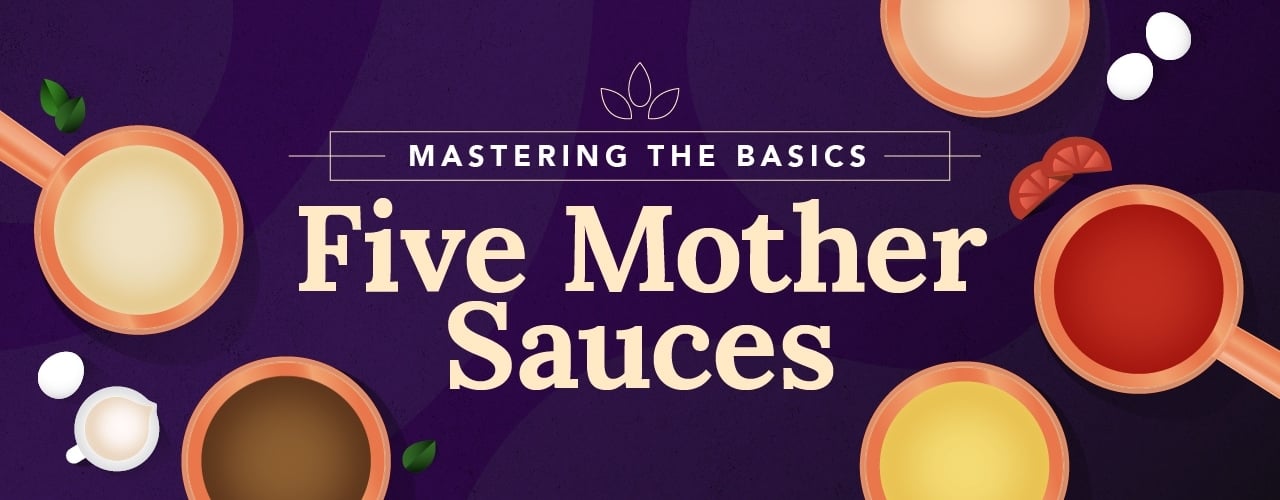What Are The Five Mother Sauces?
The five mother sauces are hollandaise, tomato (sauce tomat), bechamel, Espagnole, and veloute. French chef Auguste Escoffier identified the five mother sauces, forever associating them with French cuisine. However, mother sauces are relevant in all modern cooking practices. We can categorize nearly every sauce as an expansion, reduction, or alteration of one of the mother sauces. Whether you’re working on becoming a chef or looking to enhance your restaurant menu, mastering the mother sauces provides the foundation you need to build your own signature flavors.
Shop All SaucepansYou can click on any of the mother sauces below to discover the sauce that most interests you, read on to explore them all, or jump ahead to our five mother sauces chart.
What Is A Mother Sauce?
A mother sauce is a foundational sauce that serves as the basis for a variety of derivative sauces. A derivative sauce is a sauce that adds ingredients and flavors to a mother sauce. Chefs also refer to derivative sauces as daughter sauces, small sauces, or secondary sauces. French cuisine claims that there are five foundational mother sauces from which we form all other sauces. Each mother sauce has a unique liquid, thickening agent, and distinct flavorings. Three of the five mother sauces use a roux as their thickening agent.
Use our informative list of the five mother sauces as your guide to their flavor profiles, ingredients, popular derivatives, and common uses.
1. Hollandaise Sauce

Hollandaise offers the rich flavor of buttered cream laced with lemon and is the most well-known mother sauce. While some mother sauces are less famous than their derivatives, hollandaise is the star of its sauce family tree. Hollandaise sauce is an emulsion (meaning its ingredients don’t combine naturally). The word hollandaise is French, and it translates to “Dutch sauce” in English. While its name suggests otherwise, hollandaise is a definitively French sauce hailing from a small Norman town renowned for its butter and cream.
- Hollandaise Sauce Tastes Like - buttery cream laced with lemon
- Hollandaise Ingredients - egg yolks, unsalted butter, lemon juice, water, cayenne pepper, salt, freshly ground black peppercorns
- Uses for Hollandaise Sauce - eggs Benedict, poached salmon, flowering vegetables
- Hollandaise Sauce Derivatives - bearnaise sauce, maltaise sauce, choron sauce
Hollandaise Recipe
Follow these simple steps to make a classic hollandaise sauce.
- Melt 1/2 cup of unsalted butter.
- In a metal bowl, force four egg yolks and 1 Tbsp. of lemon juice to mix by whisking them vigorously.
- When the mixture doubles in volume, pour it into a double broiler and continue whisking.
- As soon as the color of the yolks lighten, steadily pour and whisk the melted butter into the saucepan (this keeps the eggs from scrambling).
- When the mixture doubles in volume, remove it from the heat.
- Whisk in salt, cayenne pepper, and freshly ground black peppercorns to taste.
- Keep your hollandaise sauce in a warm place until you're ready to serve it.
Note: If your hollandaise becomes too thick, whisk a few drops of warm water into the sauce before serving it.
2. Tomato Sauce

Tomato sauce, or sauce tomat in French, is a tomato-based sauce that serves as one of the five mother sauces. Tomatoes have high water content and tender flesh that cooks into thick sauces without emulsification. Tomato sauce is popular in Italian cuisine, which uses an array of secondary tomato sauces for pasta and pizza. In his publication, Auguste Escoffier didn’t signify a particular tomato variety, leaving room for seasonal availability and flavor preference. We provide the ingredients for Escoffier’s sauce tomat below.
- Tomato Sauce Tastes Like - pleasantly acidic tomatoes imbued with garlic, onion, and herbs
- Tomato Sauce Ingredients - white veal stock, butter, all-purpose flour, tomatoes, salt pork, carrots, white/yellow onion, bay leaf, thyme, garlic, salt, pepper, sugar
- Uses for Tomato Sauce - pasta, pizza, shakshouka
- Tomato Sauce Derivatives - vodka sauce, BBQ sauce, arrabbiata sauce
Tomato Sauce Recipe
While not the simplest version of tomato sauce, Escoffier's sauce tomat is as decadent as it is famous. Learn how to make the traditional tomato-based mother sauce below.
- Render 2-3 oz. of salt pork by placing it in a heavy-bottom saucepan with one tablespoon of water, covering it, and cooking it over medium heat to create steam (about 5 minutes).
- Peel and medium-dice 3 oz. of carrot and 3 oz. of white or yellow onion.
- When the salt pork is rendered, add the diced carrot, onion, and 2 oz. of butter to your saucepan.
- Cook over medium heat until the ingredients are tender and aromatic.
- Use this time to quarter 5 lb. of high-quality tomatoes.
- Create a brown roux by mixing 2-3 oz. of all-purpose flour into your saucepan and cooking the mixture until it achieves a brown shade.
- Incorporate the quartered tomatoes. Simmer them until they soften and burst.
- Add 1 clove of freshly crushed garlic and 1 qt. of white veal stock. Bring to a boil.
- Season to taste with salt and pepper. Add 1 bay leaf and 1 sprig of thyme.
- Escoffier's recipe calls for a pinch of sugar to balance the acidity of the tomatoes. Keep your sugar portion to a minimum to avoid over-sweetening the sauce.
- Cover your saucepan and leave it to simmer for 90 minutes.
- Once it's cooled enough to handle, strain your sauce through a chinois.
- Your traditional sauce tomat is ready to serve. Extra sauce will freeze and defrost well when stored in an airtight container.
To Achieve a Smoother Sauce: we recommend blending the sauce tomat before passing it through the chinois.
Back to Top3. Bechamel Sauce

Bechamel is the original cream sauce and serves as the foundation for every cheese sauce you know and love. In its simplest form, bechamel is a combination of milk and white roux. Traditional French, Greek, and Italian bechamel recipes incorporate salt and nutmeg into their sauces. Bechamel was originally an Italian sauce, Balsamella, that became a hit in the French royal court of King Louis XIV where it was renamed ‘bechamel’ after his chief steward. Escoffier standardized the name bechamel when he published his list of mother sauces.
- Bechamel Sauce Tastes Like - velvet cream with a lingering, buttery essence
- Bechamel Sauce Ingredients - butter, flour, whole milk, salt, nutmeg
- Uses for Bechamel Sauce - mac and cheese, lasagna, croque monsieur
- Derivatives of Bechamel Sauce - Alfredo, mornay, cheddar cheese sauce
Bechamel Sauce Recipe
Learn how to make bechamel sauce by following this simple recipe.
- In a large saucepan, melt five tablespoons of butter over medium heat.
- Mix 1/4 cup of flour into your melted butter until smooth.
- Cook the sauce until it turns a light sand color (approximately seven minutes). Stir constantly.
- Turn your heat to medium-high and whisk in a qt. of milk. Continue whisking the milk into the roux until it thickens.
- Lower your heat to medium-low and allow your sauce to simmer. You want the flour to soften and lose its gritty taste (approximately 10 to 20 minutes).
- Season your sauce with 2 tsp. of salt and 1/4 tsp. of nutmeg before serving/storing it.
4. Espagnole Sauce

Espagnole is a brown sauce thickened with a roux composed of brown stock, mirepoix, and tomatoes. Mirepoix is a French aromatic flavor base of onion, celery, and carrot cooked together in butter or oil over low heat, so they release their flavors without browning. Espagnole is the most complex mother sauce. It has a potent flavor that easily overpowers, so you will rarely directly apply it to your meals. Subsequently, Espagnole sauce is far more popular in its reduced, derivative forms.
- Espagnole Sauce Tastes Like - rich stock lightened with the mild acidity of tomatoes and saturated with earthy spices
- Espagnole Sauce Ingredients - butter, flour, brown stock, tomato puree, carrot, onion, celery, garlic, peppercorns, bay leaf
- Espagnole Sauce Uses - steak + French fries, braised beef short ribs + mashed potatoes, roasted lamb shanks + creamy polenta
- Derivatives of Espagnole Sauce - demi-glace, sauce bourguignon, red wine reduction
Espagnole Sauce Recipe
Easily create the most complex mother sauce with our Espagnole recipe.
- Coarsely chop 1 small carrot, 1 celery rib, and 1 medium onion.
- Cook the chopped vegetables and 1/2 stick of butter over moderate heat until golden in a heavy 3 qt. saucepan. Stir occasionally.
- Create a roux by reducing the temperature to low heat and stirring in 1/4 cup all-purpose flour. Cook to medium brown.
- Pour 4 cups of hot brown stock into the saucepan. Whisk as you pour.
- Mix in 1/4 cup tomato puree, two cloves of coarsely chopped garlic, 1/2 tsp. whole black peppercorn, and 1/2 a California bay leaf.
- Continue stirring the sauce until it comes to a boil. Then, lower the heat to a light simmer.
- Leave the sauce to simmer uncovered until it reduces to approximately 3 cups (approximately 45 minutes). Stir periodically.
- Once reduced, strain the Espagnole sauce through a cheesecloth before using it as a topping or a base for another sauce.
5. Veloute Sauce

Veloute sauce is a versatile white sauce made by blending a white roux and white stock. There are three types of veloute (chicken, fish, and veal) depending on the variety of white stock used. The most common variety is chicken veloute. Veloute is the most neutral of the five mother sauces, serving as a clean canvas to layer a diverse array of flavors onto. You’ll find veloute sauce as the base in a variety of chicken dishes, creamy soups, and other comfort food staples.
- Veloute Sauce Tastes Like - silken white stock
- Veloute Sauce Ingredients - white stock, butter, flour, salt, white pepper
- Veloute Sauce Uses - chicken supreme, cream of mushroom soup, cream of broccoli soup
- Derivatives of Veloute Sauce - white wine sauce, Allemande sauce, Normandy sauce
Veloute Sauce Recipe
Learn how to make the most versatile white mother sauce with our easy-to-follow veloute recipe.
- Melt 3 Tbsp. of unsalted butter in a saucepan over medium-low heat.
- Whisk 3 Tbsp. all-purpose flour into the butter until the mixture is smooth.
- Cook the roux until it turns blond.
- Incorporate 2 cups of white stock (chicken is the most common choice) into your roux in small increments. Each time you add more stock, whisk your mixture and bring it to a gentle boil. Repeat this process until you've added all the stock and your sauce is a velvety texture.
- Season to taste with salt and white pepper and serve.
Note: Veloute sauce thickens as it cools. If you aren't using it immediately, you can thin the sauce by adding more hot stock before serving.
Back to Top5 Mother Sauces Chart
Mother Sauces FAQs
As specialty sauces become one of the most popular food trends, it’s important for restaurants to master the mother sauces so they can create their own derivates and hone their signature flavor. We answer the common questions that arise when chefs make the five mother sauces below.
What Is a Sauce?
A sauce is a liquid combined with a thickening agent and flavorings. You can vary your thickening agent to create a sauce that is fluid, semi-solid, or anywhere in between. Sauces enhance the texture, flavor, and aesthetic appeal of other foods. You can incorporate sauces during the cooking process, add them after you plate your food, or serve them on the side.
What Is a Roux?
A roux is a thickening agent made from equal parts flour and fat. You will thicken three of the five mother sauces with a roux. To make a roux, blend flour into melted fat on the stovetop. Cook the mixture between 350-375 degrees Fahrenheit until it reaches your preferred level of browning. You can stop or extend the browning process to make a white, blonde, or brown roux.
History of Mother Sauces
Published by esteemed chef Auguste Escoffier in the 19th century, the five mother sauces are the branches of the sauce family tree, and all other sauces are leaves growing from their branches. However, the mother sauces were not always as we know them today. In the 1800s, French chef Marie-Antoine Carême classified veloute, bechamel, allemande, and Espagnole as the foundational (mother) sauces. In the 19th century, Auguste Escoffier revolutionized the culinary world by updating traditional haute cuisine and redefining the mother sauces, making him the father of modern French cuisine. Escoffier identified allemande as a derivative of veloute and removed it from the list of mother sauces. He then added tomato sauce (sauce tomat) and hollandaise to the list of foundational sauces, solidifying the five mother sauces we still recognize today.
Back to TopMother sauces are the matriarchs of the five major sauce families. Perfecting the mother sauces will allow you to venture on your own sauce journey with a solid foundation of time-tested flavor as your guide. If you’re ready to get started, check out our saucepan buying guide and discover the right saucepan for your needs.




